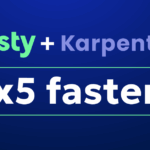
The never-ending compromise of Kubernetes optimization
As Kubernetes continues to grow in popularity as a core technology for managing containerized applications, its impact on IT operations is undeniable. By automating the deployment, scaling, and management of applications, Kubernetes transforms the infrastructure into a more efficient and responsive environment. It enhances resource utilization by dynamically adjusting to fluctuating demands without compromising performance or incurring unnecessary costs. Moreover, Kubernetes simplifies the management of complex, multi-container applications, making it easier for DevOps teams to deploy updates and manage the lifecycle of applications with minimal downtime.
But, as every coin has two sides, Kubernetes management comes with a set of challenges, complicating its management and posing an obstacle to ongoing application availability. To overcome these issues and ensure operational stability during traffic peaks, infrastructure teams are forced to overprovision resources, compromising on potential savings and affecting business agility.
This blog explores these pressing issues and highlights how Zesty’s Kubernetes optimization platform effectively addresses the challenges of deployment speed and storage scalability.
Challenges in Kubernetes Management
Lack of visibility
In Kubernetes environments, visibility is often confined to high-level metrics like service costs and node utilization. Yet, administrators and DevOps teams need granular visibility into vital components such as pod performance, workload utilization, and costs. Without this detailed insight, optimizing resource distribution and troubleshooting becomes a guessing game that can lead to inefficiencies and increased operational risks.
Configuration limitations
In Kubernetes environments, CPU, Memory and persistent volumes sizes are configured manually, based on the assumed requirements of the specific resource. To avoid the constant and time-consuming process of checking thresholds and adjusting resource allocation, users tend to overprovision the resources they need in advance to gain peace of mind.
On top of that, Kubernetes configurations are typically static, meaning that once the requested size limits are reached, the only solution is to manually provision additional resources. That poses a major issue in K8s management, as adjustments cannot be made in real time to align with actual usage needs.
Another core challenge is the time it takes to deploy new nodes in Kubernetes environments. Currently, it takes up to 5 minutes to set up a new node, which significantly hampers DevOps teams’ ability to respond in real-time to usage fluctuations. This delay leads teams to overprovision resources as a buffer against potential spikes in demand. While retaining this node headroom as a precaution ensures performance expectations are met, it also means companies are not fully capitalizing on cost-saving opportunities and are slower to identify and address resource waste.
Meeting SLAs
DevOps teams are often caught in a bind between minimizing costs and maintaining application availability and SLAs, which require applications to be highly available and responsive. This misalignment causes DevOps teams to overprovision resources to ensure they can handle peak loads, maintaining these idle resources “just in case” and tying up capital that could be employed more productively elsewhere in the organization.
Dependency on registry
Another challenge is the dependency on registry configurations, which limits the amount of images that can be retrieved per minute, meaning that in a case of large-scale node deployment, can create bottlenecks.
These challenges highlight the strategic clash in Kubernetes environments between cost saving goals and the need to ensure SLA requirements are met.
How does Zesty’s Kubernetes Optimization Platform address Kubernetes challenges?
Zesty’s Kubernetes Optimization Platform, Kompass, offers a comprehensive solution tailored to address the complex challenges of Kubernetes Optimization, focusing on efficiency and sustainability. With a holistic approach to K8s optimization, the platform not only tackles the immediate technical barriers but also adapts to ongoing needs. Here’s how each component of the platform contributes to overcoming these challenges:
- Headroom reduction: Utilizing a unique technology called HiberScale, the platform enables automated large-scale node hibernation and reactivation, deploying new nodes 5X faster. Complemented by an image caching capability, this solution reduces the need for node headroom by up to 70% without compromising SLAs.
- Spot automation: Utilizing HiberScale technology, Kompass can cover Kubernetes workloads with Spot Instances with the confidence that a new node will be up and running in time in case of Spot termination, and reduce costs by up to 70%.
- Storage Autoscaling: Through dynamic storage autoscaling, Kompass adjusts storage resources based on real-time needs, minimizing overprovisioning, significantly reducing costs, and ensuring continuous application availability.
- Insights and recommendations: The platform enhances decision-making with granular visibility into clusters and workloads and provides actionable recommendations to optimize costs in real time without impacting performance.
By resolving the traditional trade-offs between cost efficiency and application resiliency, Zesty Kompass liberates teams from the burdens of operational overhead. With our platform, organizations can focus on innovation and driving business outcomes, ensuring that their Kubernetes environments are optimized continuously and efficiently.
Click here to learn how we can help you streamline your Kubernetes costs, book a demo call with us today.








